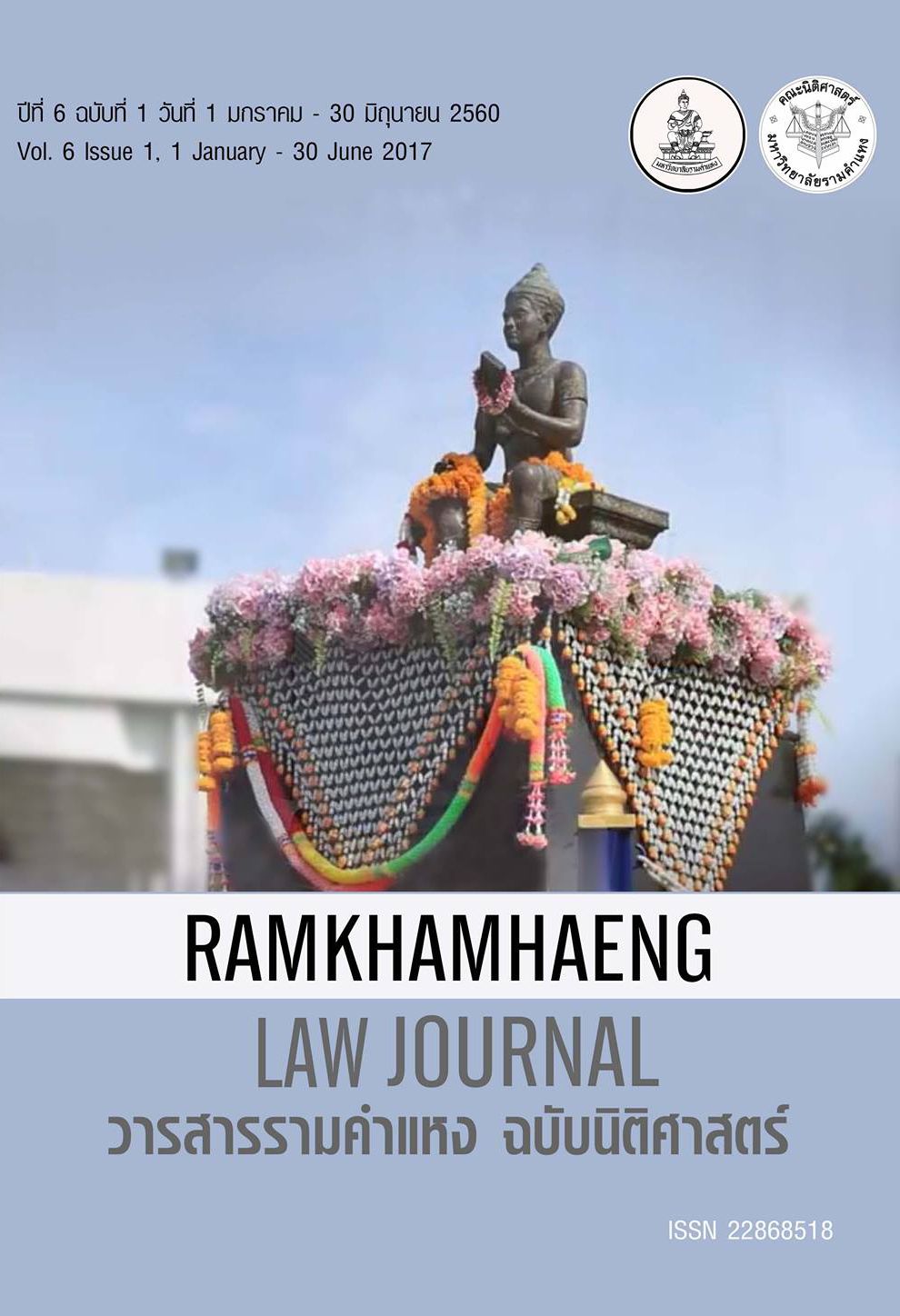ปัญหากฎหมายเกี่ยวกับความคุ้มครองสิทธิในเครื่องหมายการค้าและสิ่งบ่งชี้ทางภูมิศาสตร์
Main Article Content
Abstract
บทความนี้มีวัตถุประสงค์นำเสนอปัญหาการให้ความคุ้มครองทรัพย์สินทางปัญญาระหว่างสองสิทธิที่มีความเชื่อมโยงกัน คือ เครื่องหมายการค้าและสิ่งบ่งชี้ทางภูมิศาสตร์ ภายใต้บทบัญญัติความตกลง TRIPS ความตกลง TPP กฎหมายสหภาพยุโรป กฎหมายสหรัฐอเมริกา และกฎหมายไทย ในกรณีที่สิทธิใดสิทธิหนึ่งได้รับความคุ้มครองอยู่ก่อน อีกสิทธิหนึ่งจะสามารถนำมาคุ้มครองในภายหลังได้หรือไม่ หรือสามารถนำมาใช้ในภายหลังได้หรือไม่ หรือสามารถเพิกถอนสิทธิที่มีอยู่ก่อนได้หรือไม่ อันเป็นการช่วงชิงความเป็นเจ้าของในสัญลักษณ์หนึ่ง ๆ ประเด็นดังกล่าวนี้มีความขัดแย้งสูงในระดับระหว่างประเทศ ซึ่งได้แบ่งออกเป็น 2 ฝ่าย คือ ฝ่ายที่มุ่งคุ้มครองสิ่งบ่งชี้ทางภูมิศาสตร์ เช่น กลุ่มสหภาพยุโรป และฝ่ายที่มุ่งคุ้มครองเครื่องหมายการค้า เช่น ประเทศสหรัฐอเมริกา ประเทศออสเตรเลีย เป็นต้น ความขัดแย้งนี้นำไปสู่คดี WT/DS174/R โดย Panel ได้มีการตีความบทบัญญัติการคุ้มครองระหว่างสองสิทธิในความตกลง TRIPS ไว้บางประการ อันเป็นมาตรฐานขั้นต่ำ (Minimum Standard) ที่ประเทศสมาชิกต้องอนุวัติกฎหมายให้มีความสอดคล้อง
ผลการศึกษาพบว่าพระราชบัญญัติเครื่องหมายการค้า พ.ศ.2534 และพระราชบัญญัติคุ้มครองสิ่งบ่งชี้ทางภูมิศาสตร์ พ.ศ.2546 ให้ความคุ้มครองระหว่างสิทธิเครื่องหมายการค้าและสิ่งบ่งชี้ทางภูมิศาสตร์ไม่สอดคล้องกับความตกลง TRIPS ในกรณีที่สิทธิใดสิทธิหนึ่งได้รับความคุ้มครองอยู่ก่อน รวมทั้งขาดความเชื่อมโยงกฎหมายทั้งสองฉบับ ดังนั้น จึงมีความจำเป็นต้องแก้ไขและเพิ่มเติมบทบัญญัติทั้งกฎหมายเครื่องหมายการค้าและกฎหมายสิ่งบ่งชี้ทางภูมิศาสตร์เพื่อแก้ไขปัญหาดังกล่าว
อย่างไรก็ตาม ผู้เขียนพบว่า ประเทศไทยยังไม่เคยมีคดีพิพาทระหว่างเครื่องหมายการค้าและสิ่งบ่งชี้ทางภูมิศาสตร์เกิดขึ้น และเป็นเรื่องที่ค่อนข้างใหม่สำหรับประเทศไทย ดังนั้น ผู้เขียนจึงมักเจอคำถามอยู่เสมอว่า “เป็นไปได้หรือไม่ ที่ชื่อเครื่องหมายการค้าจะเหมือนหรือคล้ายกับสิ่งบ่งชี้ทางภูมิศาสตร์ของไทย?” “เป็นไปได้หรือไม่ ที่จะมีความขัดแย้งระหว่างสองสิทธินี้ในประเทศไทย?”เร็ว ๆ นี้ ผู้เขียนพบว่า สินค้าเบียร์ “Budejovicky Budvar” (Budweiser Budvar)สิ่งบ่งชี้ทางภูมิศาสตร์ของสหภาพยุโรป ได้มาขอยื่นจดทะเบียนเครื่องหมายการค้าในประเทศไทย เป็นที่แน่นอนว่า คำขอดังกล่าวนี้ถูกปฏิเสธ แต่ทั้งนี้ ผู้เขียนไม่ทราบแน่ชัดว่า นายทะเบียนได้ปฏิเสธด้วยเหตุผลว่าเป็นชื่อทางภูมิศาสตร์ หรือชื่อสิ่งบ่งชี้ทางภูมิศาสตร์ หรือชื่อเหมือนหรือคล้ายกับเครื่องหมายการค้า “Budweiser” ของประเทศสหรัฐอเมริกา แต่สิ่งหนึ่งที่ผู้เขียนเห็นได้ชัดเจน ในขณะนี้ว่า นี่เป็นสัญญาณแรกเริ่มของปัญหาระหว่างเครื่องหมายการค้าและสิ่งบ่งชี้ทางภูมิศาสตร์ ที่จะกำลังเกิดขึ้นในประเทศไทยในไม่ช้านี้
This article focuses on legal problems related to the protection of intellectual property, with the emphasis on two kinds of intellectual properties that are related to each other: trademark and geographical indication. The article will compare these two kinds of intellectual properties under the TRIPS Agreement, the TPP Agreement, EU law, US law, and Thai law. It seeks to answer the following questions: 1) Where a right has existed under a prior agreement, can new rights be acquired subsequently through registration or use? And 2) Can the new rights, however acquired, prevail over the prior rights? These questions may take the form of a race for the ownership of a sign that can be protected as one of the above intellectual properties. When a particular sign belongs to different owners asserting different rights, the rights come into conflict. This issue has escalated to the international level, and countries have divided into two groups. One group supports geographical indication (such as the EU), and the other group supports trademark (such as the US and Australia). These conflicting interests have led to WTO case number WT/DS174/R, where the Panel interpreted the TRIPS provisions governing the two rights and set the minimum standard that Member States will have to follow.
The result of these studies shows that the protection of trademark and geographical indication under the Trademark Act B.E. 2534, and the protection under the Geographical Indication Act B.E. 2546, is not consistent with the TRIPS Agreement, and that there is a lack of cohesion between the two Acts. It is therefore necessary to amend and suggest new provisions in both Acts in order to resolve this problem.
The author’s view is that Thailand has never had an issue between these two kinds of intellectual properties before. Therefore, this issue is rather new for Thailand. The author has frequently been asked, “is it possible that a trademark will be identical or similar to a Thai geographical indication?” and, “is it possible that there will be a conflict between the two rights in Thailand?”
Recently, the author has discovered that “Budejovicky Budvar” (Budweiser Budvar) beer, which is a geographical indication of the EU, has applied for trademark registration in Thailand. It is quite certain that this application will be rejected. However, it is unclear to the author whether the application will be refused on the ground that it is a geographical name, or because it is a geographical indication, or because it is identical or similar to the registered trademark of a United States product, namely “Budweiser.” Regardless of the outcome, this Budweiser case is, in the author’s view, a sign of a problem between trademark and geographical indication which will begin in Thailand soon.

